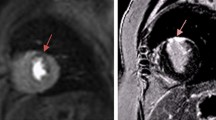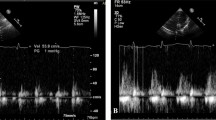Abstract
Following current practice, pediatric patients with treated congenital coronary malformations or acquired coronary disease undergo Cardio-Pulmonary Exercise Test (CPET), stress Echocardiography and Electrocardiography (sEcho, sEKG), and Coronary Angiography (CA). Stress cMRI can assess cardiac function, myocardial viability, and stress/rest perfusion deficit—without radiation exposure, general anesthesia, and hospitalization—in a single non-invasive exam. The aim of our pilot study is to assess the feasibility and diagnostic accuracy of Dobutamine stress cMRI compared to the current procedures (sEcho, CPET, CA). The prospective study is focused on pediatric patients, at risk for or with previously diagnosed coronary artery disease: d-looped TGA after arterial Switch, Kawasaki disease, and anomalous origin of left coronary artery from pulmonary artery (ALCAPA) after coronary artery reimplantation. We have compared the results of MRI coronary angiography, and Dobutamine stress cMRI with traditional tests. All these diagnostic exams were acquired in a timeframe of 3 month, in a blinded fashion. All the 13 patients (age: 12 ± 2 years, median 12,7 y) recruited, completed the study without major adverse events. The mean heart rate-pressure product was 25,120 ± 5110 bpm x mm Hg. The target heart rate of 85% of the maximal theoretical was reached by 10 (77%) patients. The comparison between cardiac MRI coronarography versus the gold standard Coronary Angiography to identify the patency of the origin and the proximal pathway of the coronary arteries shows a sensitivity of 100% (confidence interval: 2,5–100%), specificity 92% (confidence interval: 64–100%). The stress test was well tolerated for the 77% of the patients and completed by the totality of patients (Table 3). Three patients (23%) had mild symptoms: nausea, vomiting, or general discomfort. In pediatric patients with a potential or definite diagnosis of coronary artery disease, stress cMRI combines an effective assessment of proximal coronary arteries anatomy with cardiac function, myocardial perfusion, and viability in a single examination. Stress cMRI can be proposed as alternative, standalone test.




Similar content being viewed by others
Data Availability
All data and materials as well as software application or custom code support their published claims and comply with field standards.
References
Legendre A, Losay J, Touchot-Koné A et al (2003) Coronary events after arterial switch operation for transposition of the great arteries. Circulation 108:186–190
McCrindle BW, Rowley AH, Newburger JW et al (2017) Diagnosis, treatment, and long-term management of Kawasaki Disease: a scientific statement for health professionals from the American Heart Association. Circulation 135:e927–e999
Nandalur KR, Dwamena BA, Choudhri AF et al (2007) Diagnostic performance of stress cardiac magnetic resonance imaging in the detection of coronary artery disease: a meta-analysis. J Am Coll Cardiol 50:1343–1353
Gargiulo P, Dellegrottaglie S, Bruzzese D et al (2013) The prognostic value of normal stress cardiac magnetic resonance in patients with known or suspected coronary artery disease: a meta-analysis. Circ Cardiovasc Imaging 6:574–582
Bikiri E, Mereles D, Voss A et al (2014) Dobutamine stress cardiac magnetic resonance versus echocardiography for the assessment of outcome in patients with suspected or known coronary artery disease. Are the two imaging modalities comparable? Int J Cardiol 171:153–160
Gebker R, Jahnke C, Manka R et al (2011) The role of dobutamine stress cardiovascular magnetic resonance in the clinical management of patients with suspected and known coronary artery disease. J Cardiovasc Magn Reson 13(1):46
Lipinski MJ, McVey CM, Berger JS et al (2013) Prognostic value of stress cardiac magnetic resonance imaging in patients with known or suspected coronary artery disease: a systematic review and meta-analysis. J Am Coll Cardiol 62(9):826–838
Ntsinjana H, Hughes M, Taylor AM (2009) The role of cardiovascular magnetic resonance in pediatric congenital heart disease. JCMR 29:313–319
Robbers-Visser D, Luijnenburg SE, Van den Berg J (2009) Stress imaging in congenital cardiac disease. Cardiol Young 19:552–562
Noel CV, Krishnamurthy R, Moffett B et al (2017) Myocardial stress perfusion magnetic resonance: initial experience in a pediatric and young adult population using regadenoson. Pediatr Radiol 47(3):280–289
Biko DM, Collins RT 2nd, Partington SL et al (2018) Magnetic resonance myocardial perfusion imaging: safety and indications in pediatrics and young adults. Pediatr Cardiol 39(2):275–282
Doan TT, Wilkinson JC, Loar RW et al (2019) Regadenoson stress perfusion cardiac magnetic resonance imaging in children with Kawasaki Disease and Coronary Artery Disease. Am J Cardiol 124(7):1125–1132
Vijarnsorn C, Noga M, Schantz D et al (2017) Stress perfusion magnetic resonance imaging to detect coronary artery lesions in children. Int J Cardiovasc Imaging 33(5):699–709
Buechel ER, Balmer C, Bauersfeld U et al (2009) Feasibility of perfusion cardiovascular magnetic resonance in paediatric patients. J Cardiovasc Magn Reson 11:51
Manso B, Castellote A, Dos L et al (2010) Myocardial perfusion magnetic resonance imaging for detecting coronary function anomalies in asymptomatic paediatric patients with a previous arterial switch operation for the transposition of great arteries. Cardiol Young 20(04):410–417
Ntsinjana HN, Tann O, Hughes M et al (2017) Utility of adenosine stress perfusion CMR to assess paediatric coronary artery disease. Eur Heart J Cardiovasc Imaging 18(8):898–905
Schmitt B, Bauer S, Kutty S et al (2014) Myocardial perfusion, scarring, and function in anomalous left coronary artery from the pulmonary artery syndrome: a long-term analysis using magnetic resonance imaging. Ann Thorac Surg 98(4):1425–1436
Doan TT, Molossi S, Sachdeva S et al (2021) Dobutamine stress cardiac MRI is safe and feasible in pediatric patients with anomalous aortic origin of a coronary artery (AAOCA). Int J Cardiol 334:42–48
Strigl S, Beroukhim R, Valente AM et al (2009) Feasibility of dobutamine stress cardiovascular magnetic resonance imaging in children. J Magn Reson Imaging 29(2):313–319
Robbers-Visser D, Jan Ten Harkel D, Kapusta L et al (2008) Usefulness of cardiac magnetic resonance imaging combined with low-dose dobutamine stress to detect an abnormal ventricular stress response in children and young adults after fontan operation at young age. Am J Cardiol 101:1657–1662
Hill KD, Frush DP, Han BK et al (2017) Image gently alliance. Radiation safety in children with congenital and acquired heart disease: a scientific position statement on multimodality dose optimization from the image gently alliance. JACC Cardiovasc Imaging 10(7):797–818
Noto N, Ayusawa M, Karasawa K et al (1996) Dobutamine stress echocardiography for detection of coronary artery stenosis in children with Kawasaki disease. J Am Coll Cardiol 27(5):1251–1256
Legendre A, Losay J, Touchot-Kone A et al (2003) Coronary events after arterial switch operation for transposition of the great arteries. Circulation 108:186–190
Goodchild CS, Serrao JM (2015) Propofol-induced cardiovascular depression: science and art. Br J Anaesth 115(4):641–642
Acknowledgements
The authors thank all the Technicians and Nurses of our Cardiac MRI Unit for their contribution, and in general to their dedication for Cardio-Radiology Team since its foundation in 2007. We thank Doctor Giollo for the trust and for the support to the project.
Funding
Guerbet (Villepinte, France) supported this study with an unrestricted grant provided to the Gaslini Hospital, but had no role in study design, data collection, analysis, interpretation, or writing of this report.
Author information
Authors and Affiliations
Contributions
All authors contributed to the study conception and design. Material preparation, data collection, and analysis were performed by Nicola Stagnaro and Gianluca Trocchio. The first draft of the manuscript was written by Nicola Stagnaro and all authors commented on previous versions of the manuscript. All authors read and approved the final manuscript.
Corresponding author
Ethics declarations
Conflict of interest
The authors declare that they have no conflict of interest.
Ethics Approval
This interventional, diagnostic study was conducted prospectively in a single center. The study was approved by Ethical Committee (Number: 519REG2016). The study is registered at Clinical Trials.gov (Identifiers: NCT04022395).
Consent to Participate
Written informed consent was obtained from the parents.
Consent for Publication
The authors affirm that human research participants and their parents provided informed consent for publication of the images.
Additional information
Publisher's Note
Springer Nature remains neutral with regard to jurisdictional claims in published maps and institutional affiliations.
Study target and clinical impact: Our aim is to assess the diagnostic accuracy of stress cardiac MRI compared to the current procedures (Stress Echocardiography, Cardiopulmonary Exercise Test, Coronary Angiography), which are limited by hospitalization, a radiation dose, and with the inherent risk of invasive procedure under general anesthesia. Stress cardiac MRI represents a significative diagnostic improvement even for the patients who are unable to cooperate sufficiently for exercise stress testing or have poor acoustic windows. To our knowledge, this is the first study to assess the diagnostic accuracy of Dobutamine stress cardiac MRI, and to compare systematically the results with the available diagnostic techniques (Stress Echocardiography, Stress Electrocardiogram, Cardiopulmonary Exercise Test, Coronary Angiography) in pediatric patients with a suspected, or known coronary artery disease.
Rights and permissions
Springer Nature or its licensor holds exclusive rights to this article under a publishing agreement with the author(s) or other rightsholder(s); author self-archiving of the accepted manuscript version of this article is solely governed by the terms of such publishing agreement and applicable law.
About this article
Cite this article
Stagnaro, N., Moscatelli, S., Cheli, M. et al. Dobutamine Stress Cardiac MRI in Pediatric Patients with Suspected Coronary Artery Disease. Pediatr Cardiol 44, 451–462 (2023). https://doi.org/10.1007/s00246-022-03007-7
Received:
Accepted:
Published:
Issue Date:
DOI: https://doi.org/10.1007/s00246-022-03007-7




